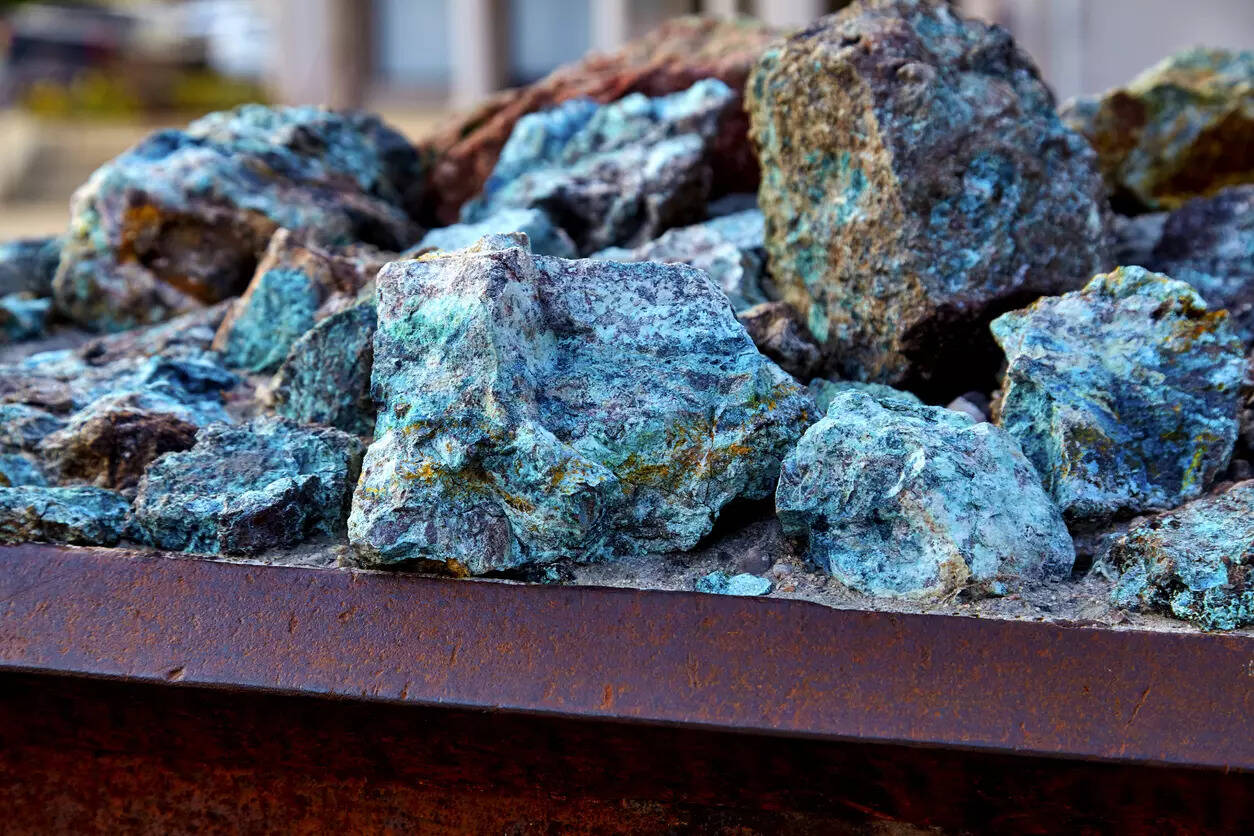
Lithium is the new gold. This soft, silvery white metal is essential for a range of products — from batteries of electric vehicles, mobile phones and laptops to hydrogen fuel storage, air conditioning systems and pharmaceuticals. Even though a vast array of industries hinges on this single metal, India does not produce even a kilogram of it. Recently, India announced the discovery of 5.9 million tonnes of lithium reserves in Jammu and Kashmir and the government is contemplating amending laws to pave the way for private miners to dig it up. But that may take a while.
For now, India imports lithium, and it relies mainly on China and Hong Kong. China accounted for 73% of India’s imports of lithium-ion — which is used in batteries — in 2020-21. Add Hong Kong and India’s import reliance on them shot up to a staggering 96%.
Besides lithium, there are several critical minerals such as cobalt, nickel, vanadium, niobium, germanium, rhenium, tantalum and strontium, which India imports entirely. Then there are others such as copper, gallium, graphite, phosphorus, potash, tin, titanium and tungsten, which carry high economic significance as well as supply risks.
All these metals have figured on the Government of India’s recent list of 30 critical minerals, which are instrumental to the country’s economic growth and national security. India Inc has applauded the move but wants a definitive policy that lays down guidelines for private engagement and which incentivises it to mine and process them.
Demand for some of these metals is set to zoom and even a small disruption in their supply chains will cripple industries such as high-tech electronics, telecommunications, transport and defence. According to industry estimates, the demand for lithium and cobalt, for example, may grow by 42 and 25 times respectively, between 2020 and 2040.
Tarun Mehta, CEO of Ather Energy, says the government has taken the first step towards de-risking supply chains and it should incentivise industries to mine and refine the metals. “Bringing parts of the value chain to the country will make EV batteries cheaper and help develop EV adoption across the country,” says Mehta. Ather Energy is an electric two-wheeler manufacturer with production facilities in Bengaluru and Hosur.
Vivek Srivastava, CEO of solar module manufacturer Waaree Energies, says “it is alarming” how the processing of many such metals is concentrated in certain geographies, with China having a significant presence across the board. “The current supply and investment plans are inadequate to service the transformation of India’s energy sector, which could possibly lead to delays in transition,” he says. The world is still relying on fossil fuels as threefourths of energy supply come from oil, coal and natural gas, but once it shifts gears towards low-carbon technologies such as solar and wind, many critical minerals will play a crucial role.
While more and more nations are enthusiastic about a low-carbon regime, there is also a realisation that the landscape of new energy minerals is tilted in favour of a handful of countries. Bolivia houses the world’s largest deposits of lithium, although it has not mined the metal yet. Nearly half the world’s lithium is mined in Australia. A report titled “Addressing Vulnerabilities in the Supply Chain of Critical Minerals” published in April and authored by multiple agencies, including the Council on Energy, Environment and Water (CEEW), says China accounts for the production of 79% natural graphite, a mineral used in batteries, lubricants, fuel cells, et al. India houses about 9 million tonnes of graphite of which only a small portion has been mined so far.
Globally, the CEEW report says, only 15 countries are home to at least 55% (up to 90% in certain cases) of seven minerals — cobalt, copper, graphite, lithium, manganese, nickel and rare earth element (REE). These countries are Australia, Brazil, Chile, China, Congo, Gabon, Indonesia, Madagascar, Mozambique, New Caledonia, Peru, Philippines, Russia, South Africa and the US. Each of these minerals is of immense value to new-age industries. Cobalt is used for battery electrodes, turbine engine components and automobile airbags, while nickel is an important ingredient in solar panels, batteries, aerospace and defence applications and EVs. India imports both these items. Clearly, an energy transition could be turbulent for countries like India which don’t figure on the critical minerals map. India has to either explore new deposits or ensure a guaranteed supply from foreign locations despite turbulent and changing geopolitics.
Economist Pronab Sen argues that, meanwhile, India should consider stockpiling some critical materials. “If we do that, we have to figure out how much we should stockpile and over what period of time. After all, such a move will require a whole lot of investments,” he says, insisting that the research community must play a big role in finding alternative metals and processes.
More Ore
Rishabh Jain, senior programme lead of CEEW, says India must chart a path on how to use these minerals, right from mining to end-use value chains, which will create jobs and help the economy grow further. He says the government should also periodically calibrate the list of 30 minerals on the basis of priorities and geo-political dynamics.
This means the government has to institutionalise a mechanism. According to Srivastava of Waaree Energy, the government should set up a task force to look into the entire chain, from identifying reserves to production and processing. Several countries are emphasising on the processing part. China, for example, dominates in processing rather than in producing many minerals, Srivastava adds. Europe is also fast learning the trick. Though Congo accounts for 70% of global cobalt production, Finland, Belgium and Norway are leading in the production of refined cobalt, a processed product.
At this juncture, a viability gap funding (VGF), a kind of government subsidy, is needed to localise the processing of minerals, says Randheer Singh, former director of electric mobility at NITI Aayog. “Industry also needs targeted R&D and testing facilities for critical minerals for managing clean energy and EV applications,” he adds.
The government and the industry have been upping renewable energy targets. India’s EV market is likely to cross 10 million units a year by 2030, up from 1 million in 2022. But that can be possible only if there’s no major disruption in the supply of its inputs.
“With the government announcing its target of installing 37 gigawatt (GW) of offshore wind projects by 2030, and onshore wind targets of about 10 GW additions per annum till 2028, India will need to boost its wind turbine manufacturing capabilities,” says Sumant Sinha, founder and chairman of ReNew, a leading clean energy company. Turbines require rare earth elements.
Lithium is a major input for battery energy storage systems, which can store energy from various sources such as solar and wind. Easier and cheaper availability of lithium will reduce the cost of manufacturing storage batteries, Sinha adds. Rahul Lamba, CEO of The Energy Company, says more and more of these metals have to be processed in India itself to reduce the final product cost. Lamba, who runs the Bengaluru-based startup that manufactures batteries for EVs, adds that localising the refining process of copper and nickel may reduce the cost of a vehicle by INR 15,000-20,000.
While most of the 30 critical minerals are related to renewable energy and defence industries, two are agri items—phosphorus and potash. “I am not surprised by their inclusion as energy security and food security are the two most critical components for any nation’s progress,” says former Union agriculture secretary SK Pattanayak. “India’s agriculture will collapse if there’s no import of phosphorus. We have domestic deposits in isolation but we have always preferred imports to mining. It’s high time we dug up phosphorus,” he says.
Critical Minerals which India imports entirely (Data Pertains to 2020)
Lithium
Used in: Rechargeable batteries (of phones, computers and EVs), hydrogen fuel storage, military ballistic armour, aircraft, train components
Import Source: Hong Kong, China, Indonesia, Singapore, South Korea
Cobalt
Used in: Battery electrodes, turbine engine components, automobile airbags, drying agents for paints
Import Source: China, Belgium, Netherlands, US, Japan
Nickel
Used in: Jet and combustion engine components, rechargeable batteries (phones, computers, EVs), industrial manufacturing machines
Import Source: Sweden, China, Indonesia, Japan, Philippines
Vanadium
Used in: Military armour plating, vehicle axles, nuclear reactor components
Import Source: Kuwait, Germany, South Africa, Brazil, Thailand
Niobium
Used in: Jet engines, rockets, MRI scanners, oil rigs and pipelines Import Source: Brazil, Australia, Canada, South Africa, Indonesia
Germanium
Used in: Fibre-optic communication networks, camera and microscope lenses, infrared night vision systems
Import Source: China, South Africa, Australia, France, US
Rhenium
Used in: Aerospace products, refined petroleum products
Import Source: Russia, UK, Netherlands, South Africa, China
Beryllium
Used in: Computer, electronic and optical products
Import Source: Russia, UK, Netherlands, South Africa, China
Tantaum
Used in: Capacitors, gas turbine components, missiles and radio communication systems
Import Sources: Australia, Indonesia, South Africa, Malaysia, US
Strontium
Used in: Casting of non-ferrous metals, bike accessories
Import Source: China, US, Russia, Estonia, Slovenia
The remaining 20 minerals are:
antimony, bismuth, copper, gallium, graphite, hafnium, indium, molybdenum, platinum-group elements, phosphorous, potash, rare earth elements, silicon, tellurium, tin, titanium, tungsten, zirconium, selenium and cadmium.

